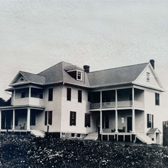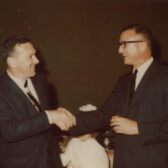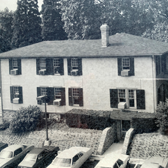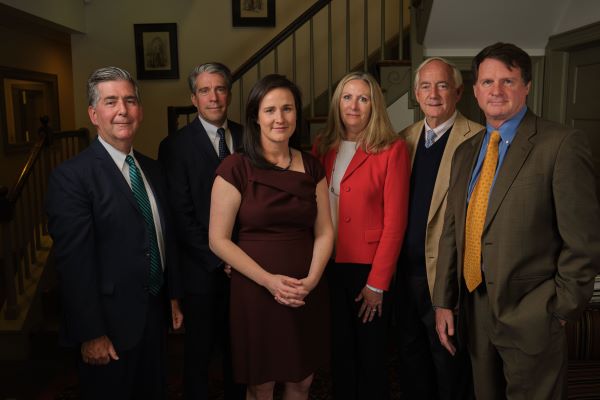1946
The Founding of Montgomery County’s Oldest Law Firm.
James R. Miller, Sr. joined the Maryland Bar in 1941, prior to the start of World War II. But his entry into practice was delayed as he, like many others, answered his country’s call. An officer in the Marine Corps Reserves, Miller served in the Pacific and was severely wounded on Saipan in June 1944. For his heroism there, he was awarded the Silver Star. He spent nearly a year in various Navy hospitals learning to walk again and adjusting to his physical condition. He retired as a major in December 1945.
As he had planned to do when the war was over, Jim Miller, Sr. opened a law office in Rockville, Maryland, which prospered from the start. For the first months of his practice his wife, Lee C. Miller, herself a graduate of law school but working then in Washington, D.C., during the day assisted him at night. After a few months, the firm was clearly outgrowing its one-person practice, so Lee left her job and passed the Maryland Bar, becoming just the 149th woman admitted, and joined her husband in what became Miller & Miller.
LATE
40s
EARLY
50s
The Evolution of Montgomery County Spurs the Growth of a Firm.
In the late 40s and early 50s, Montgomery County was changing from a predominately rural area to a suburban county, with population rapidly growing both in numbers and income. Highways were planned and constructed, public facilities necessary to serve the expanding population were built, and housing projects and shopping centers were planned, financed, built, sold and leased in increasing numbers. This evolution brought governmental change with it and, after a struggle, the Charter was adopted for Montgomery County. This environment created plenty of legal business which Miller & Miller undertook.
Lee Miller concentrated on wills, estates, real estate settlements, and running the office while Jim Miller, Sr. did just about everything else. Landowners who wanted to sell their property to developers or develop their land themselves came to Jim for help, as did those who were fighting eminent domain suits or negotiating with the Park & Planning Commission or Public Works for permits. Contractors seeking to be paid or defending against perceived unjust claims also came to Jim for help in court, as did tort claimants. As zoning regulations were instituted in the upper county and tightened in the lower county, Miller & Miller’s reputation for representing clients before zoning officials grew.

1952
A Permanent Home.
In 1952, the Spiedel property at 200 Monroe Street in Rockville came on the market. It consisted of several acres of land on which was located the old “Hege” house, built in the late 1890s and in poor repair. Lee and Jim Miller, recognizing the property’s potential for office development and in need of a solution to their own crowded offices, bought the property. They restored the large house, remodeled it into attractive offices, and in 1953 moved the offices of Miller & Miller to the first floor of what was then renamed the “Miller Building.” It has been the firm’s home ever since. In 1983 the building was substantially expanded to accommodate the growing firm, but the historic features of the Hege house were maintained.
october
1955
A Familiar—and Familial—Addition.
In October 1955 James R. Miller, Jr., a Georgetown Law School graduate who had passed the District of Columbia’s Bar examination before graduation, joined the firm. While waiting to take the Maryland Bar exam, he appeared in court in Maryland pro hac vice as a member of the D.C. bar. In March 1956 Jim Miller, Jr. took the Maryland Bar exam and received the third highest mark in the State. He was admitted to practice in Maryland in June 1956. Jim Miller, Jr., joined the firm as a partner, but the firm name remained unchanged to avoid confusion with James Robert Miller, H. Ralph Miller, and William Miller, three brothers practicing together in Silver Spring as “Miller, Miller & Miller.”
In 1956 Jim Miller, Sr. and the firm received Martindale Hubbel’s coveted “A” rating, indicating that legal colleagues viewed both Jim Miller, Sr. and the firm as excellent in skill and integrity. Such a rating is awarded only to qualifying lawyers who have been practicing at least ten years. Jim Miller, Sr. had for a number of years been developing an expertise in the appeal of ad valorem tax assessments of commercial, industrial and multi-family real property. He was thoroughly familiar with the methods of determining the fair market value of real property. The assessors respected his expertise as did the administrative boards and courts, which heard challenges to the valuations asserted by the assessors.
In 1957, Jim Miller, Jr. took on the task of creating an organization of businessmen in Rockville to replace the one or two previous such groups which had disbanded. The result was the formation of the Rockville Chamber of Commerce of which Jim Miller, Jr. was Charter President.
october
50s
Canby Solidifies the Team.
William (“Bill”) M. Canby’s family had been in Montgomery County for many generations. His father was one of the leaders in getting the County’s Charter adopted. In the mid 50s, Bill Canby started law school at Washington & Lee University, where he had been an undergraduate as well, but the Korean War and active duty as a young Naval Reserve officer interrupted his education. His marriage to Nancy Yesaire during his active duty resulted in his decision to finish his last two years at the University of Maryland Law School from which he graduated in 1958. He clerked for Judge Henderson on the Court of Appeals and, upon finishing, went to work at the County Attorney’s office. He wanted to practice in Montgomery County where his roots were so deep.
During Bill Canby’s clerkship, then Chief Judge Prescott became impressed with Bill’s abilities. Chief Judge Prescott also knew and respected the Millers, having engaged Jim Miller, Sr. to represent him several years before. When Jim asked if he could recommend any young lawyer as a possible associate in the firm, Judge Prescott’s answer was Bill Canby.
Bill Canby became an associate of Miller & Miller in 1961. He was a natural lawyer and a man of impeccable integrity. He was practical and knowledgeable in many areas. His family’s involvement in Montgomery County and familiarity with many of its residents enabled him to establish new client relationships as soon as the announcement of his association with Miller & Miller went out. Many of these clients, and their descendants, have remained clients of the firm to this day.
Bill Canby became a partner in 1963 and the firm’s name was changed to “Miller, Miller & Canby,” a name that still stands today in honor of its outstanding founding lawyers. While the County’s evolution from a predominantly rural outpost to one of the Country’s wealthiest counties continued unabated, the Millers and Bill Canby solidified its practice in the areas of real property, land use & zoning, eminent domain, business & tax, estate planning & administration, and litigation.
october
60s
The 1960s
Celebrating our 75th Anniversary provides us an opportunity to reflect on our heritage as a law firm and the individuals whose contributions impacted our growth and the clients and community we serve, as well as the legal profession. It is also an opportunity for us to share this history with you, our clients and friends, who have been as much a part of this history as the attorneys who have been privileged to serve you. This is the second of a four-part reflection on our journey as a law firm and of the attorneys who were a part of it.
Embarking on a Decade of Growth and Political Service
At about the same time that the firm welcomed Bill Canby as a partner, formally changing its name to “Miller, Miller & Canby”, Jim Miller, Jr.’s career path took him in a direction he may not have imagined. He had been elected to the Maryland House of Delegates in the 1962 election, and was made the Chairman of the Montgomery County Delegation shortly thereafter. In addition to his duties during the General Assembly Session and associated with his Chairmanship, Jim Miller, Jr., continued his law practice, handling zoning and subdivision matters, trial work and other legal matters. Another area in which he excelled was in handling ad valorem tax assessment appeals for the increasing number of commercial, multi-family and industrial property owners who were becoming more prevalent as Montgomery County’s transition from its agricultural roots began to expand. Among some of his more notable clients were the Dow Jones Company, Westwood Development Corporation, managed by Lazlo Tauber, and the Polinger Companies.
It was during the course of representing Westwood Development Corporation in appealing the denial of a zoning application that Jim Miller, Jr. appeared opposite Robert Burchett, then an assistant County Attorney. He was so impressed with Bob Burchett’s handling of the case that he immediately went to Bill Canby to discuss trying to hire him. That effort proved successful, and Bob Burchett joined the firm as an associate in May, 1966.
The Interesting Career Trajectory of Jim Miller, Jr.
The hiring of Bob Burchett could not have come at a better time for Jim Miller, Jr. He was becoming well known throughout the State for both his legal and legislative activities, was active in the Montgomery County Chamber of Commerce and, along with Bill Canby, was also part of the leadership of the Montgomery County Bar Association. In 1966, believing that his work in the legislature was taking too much time from his active law practice, Jim Miller, Jr. announced he would not seek re-election. Yet, in the summer of that year, Spiro Agnew approached him to manage his Montgomery County primary campaign in his bid for the Republican nomination for Governor. Jim Miller, Jr. accepted, and while not willing to run for re-election himself, agreed with local party leaders to run for the Republican local Central Committee and was made its Chairman.
Spiro Agnew won his party’s nomination overwhelmingly in the County, as well as the State, and Jim Miller, Jr. became the Chairman of the Agnew Campaign in Montgomery County. The Republicans won a narrow majority of offices in the local election but Spiro Agnew carried Montgomery County in a landslide, giving him a statewide victory in the race for Governor. Jim Miller, Jr. was offered a position as the Governors’ Legislative Liaison, but he declined in order to pursue his law practice full-time, although he agreed to serve on a volunteer basis until the position was filled.
In 1967, Jim Miller, Jr. was back, full-time in the law office, but meeting weekly at breakfast with the Governor and legislative leaders in Annapolis to help prepare and carry out the Governor’s program. That same year, Jim Miller, Jr., as chairman of the Central Committee, successfully directed the recruitment and the election of Montgomery County delegates to the Maryland Constitutional Convention which was to convene in 1968 to consider writing a new State Constitution. He was later named by the Governor to be his liaison with the Chairman of the Convention.
By the time of the political conventions in the summer of 1968, Jim Miller, Jr. had resigned as Chairman of the Republican State Central Committee to devote even more time to Miller, Miller & Canby. That was, until Spiro Agnew was nominated by the Republican Party to be its Vice Presidential candidate. Two days after the Convention ended, Jim was asked to be Spiro Agnew’s liaison with the Nixon Campaign in New York. With the consent and encouragement of his wife, his father and Bill Canby, Jim accepted. Throughout this time, Jim met daily with other prominent members of the campaign to plan national campaign strategy and react to changing news and polls. History tells you that the election, while close, resulted in Richard Nixon becoming President, and Spiro Agnew the Vice President.
Two days after the election, Jim was back at Miller, Miller and Canby practicing law. He became President of the Montgomery County Bar Association in the summer of 1969 and also continued to serve on the Governor’s Commission for the Reorganization of the State Government, known as the Curlett Commission. The Curlett Commission’s report was substantially enacted into law, creating the Cabinet departments of the executive branch which we have today.
In the fall of 1969, Jim Miller, Jr. received a call that President Nixon wanted to nominate him to the U.S. District Court of the District of Maryland. He was surprised and honored by the confidence. After consultations with his family, and with Bill Canby, all of whom encouraged him to accept, he did. Through the help of a number of friends and colleagues, among them Jim and John McAuliffe, Jim Miller, Jr. received the approvals of the American, State and local Bar Associations of his qualifications to sit on the federal bench. He was ultimately nominated by the President, confirmed by the Senate and given the oath of office in November, 1970 where he served before retiring from the bench in 1986. After a respite of several years, Jim Miller returned to Miller, Miller & Canby and engaged in a heavy private arbitration practice built upon his reputation as an outstanding jurist until he retired in 2004.

Bill Canby (right) congratulates Jim Miller, Jr. upon his investiture as a judge of the U.S. District Court for the District of Maryland, 1970.
1970
to
PRESENT
.

The Miller House after the 1983 renovation.
1970 to Present Day: The Legacy Continues.
In 1970 Jim Miller, Jr. was nominated to the U.S. District Court of the District of Maryland by President Nixon and confirmed by the Senate. He served for 16 years and earned a reputation from both sides of litigated matters as a fair, impartial and brilliant jurist. After a several year respite, Jim returned to Miller, Miller & Canby and engaged in a heavy private arbitration practice, built on his reputation as an outstanding jurist, until he retired at the end of 2003.
From the late 1970s through the 1980s the firm evolved from a general practice law firm which undertook legal representation in nearly every area of law to a more specialized practice focused on all issues touching real property: land use & zoning, and real estate (zoning, eminent domain, ad valorem tax appeals, sale and lease transactions, and financing); the related business needs of clients (business and tax, and estates planning & administration); and litigation that flowed from these practice areas. These specialized areas remain at the core of the firm’s practice today.
While it is impossible to give the deserved attention and credit to all of the partners and associates who have contributed to the firm’s continued success over the last five decades, we are proud to say that every one of our attorneys maintains the client-focused and results-driven code of the firm’s founders.

Subscribe to our Legal News & Notes Newsletter!
Receive quarterly emails with the latest legal news and firm highlights directly to your inbox. SUBSCRIBE
